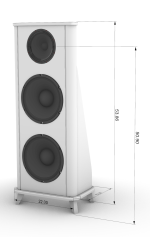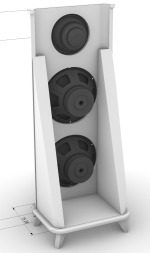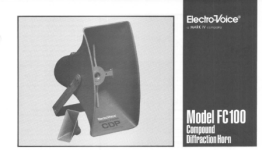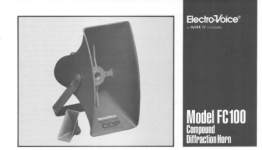So i did play around a little bit with the Device Console. There is a fundamental difference between the "Flex 8" and the Flex. Flex 8 has FIR's on the input which you used and the Flex does not, only on outputs.I don't know for sure but I doubt files for Flex 8 are interchangeable with Flex. I have never used a Flex so I don't have files for it.
I may be wrong but they appear to use the same configuration tool (MiniDSP Device Console) so it looks like you could manually copy the filter settings from my Flex Eight files and reproduce them in the Flex environment. This would not be very difficult.
Don't hold me to this though. You need to contact MiniDSP to find out for sure.
My conclusion is therefore, i better stick to the 2-4 HD files you posted and use this as a basis to copy and paste to my Flex.
I was trolling through older OB/dipole designs and noticed these Lotus Group Granada speakers with a significant wing on just one side.That's a fascinating insight! Asymmetrical baffles indeed add another layer to the design considerations.
No idea what they sound like, but interesting to see.
Hi, to all
i have a Minidsp 4x10hd..... could this dsp be an alternative to
the recommended models (2x4hd, flex8) in this project?
i have a Minidsp 4x10hd..... could this dsp be an alternative to
the recommended models (2x4hd, flex8) in this project?
It can work, but the existing DSP files are not interchangeable so you need to find a way to copy the settings over to the 4x10. Also the 4x10 doesn’t have FIR filters so the system won’t be linear phase.Hi, to all
i have a Minidsp 4x10hd..... could this dsp be an alternative to
the recommended models (2x4hd, flex8) in this project?
@perrymarshall
I happen to have a set of Beyma 15XA38ND Coaxials. I know you rejected these in preference to B&C. Despite, do you think I may be able to use these to make a version of your Bitches Brew ?
Thanks!
Jayant
I happen to have a set of Beyma 15XA38ND Coaxials. I know you rejected these in preference to B&C. Despite, do you think I may be able to use these to make a version of your Bitches Brew ?
Thanks!
Jayant
@perrymarshall
Thank you for all your help.
1) About the wings: Are the wings detachable? If not, are they attached with dowel rods, biscuits, or ?? Anything to watch out for?
2) About high Xmas, rubber surround drivers: You mentioned you did not think a typical high Xmas, rubber surround subwoofer driver would mate well with a Radian coaxial. Stereo Integrity, which makes the BM-11, also makes an HT-18 v3 with Qts = 0.59, Fs = 23, Xmas = 25 mm, SPL = 91.7 (4 ohms), but Mms is 434 g. Would a solid amp with very low output impedance (high damping) do a decent job to mate? Their cost seems low enough to try, and they would put out about 3 times the volume of the 18" Kappa LF. If not a reasonably good match, what changes in parameters need to happen?
Thank you for all your help.
1) About the wings: Are the wings detachable? If not, are they attached with dowel rods, biscuits, or ?? Anything to watch out for?
2) About high Xmas, rubber surround drivers: You mentioned you did not think a typical high Xmas, rubber surround subwoofer driver would mate well with a Radian coaxial. Stereo Integrity, which makes the BM-11, also makes an HT-18 v3 with Qts = 0.59, Fs = 23, Xmas = 25 mm, SPL = 91.7 (4 ohms), but Mms is 434 g. Would a solid amp with very low output impedance (high damping) do a decent job to mate? Their cost seems low enough to try, and they would put out about 3 times the volume of the 18" Kappa LF. If not a reasonably good match, what changes in parameters need to happen?
For those on a budget it might be worth noting that the Radian 508 is the same as the 5208 except for the pressed steal basket.
Yes, you can certainly use them and I believe most people will be happy with them.@perrymarshall
I happen to have a set of Beyma 15XA38ND Coaxials. I know you rejected these in preference to B&C. Despite, do you think I may be able to use these to make a version of your Bitches Brew ?
Thanks!
Jayant
Reasons I switched to the 15CXN88:
1) The Beyma tweeter has erratic, non-constant-directivity polar pattern between 4K and 7K. I wanted a no-compromise design and was willing to spend 2X more to achieve that.
2) They Beyma tweeter has somewhat narrower dispersion above 10K. That means you need to make extra sure that the tilt of the front panel points the Beyma right at your listening spot and not above or below.
The woofer section is very high quality and it's a very well built driver.
@perrymarshall
Thank you for all your help.
1) About the wings: Are the wings detachable? If not, are they attached with dowel rods, biscuits, or ?? Anything to watch out for?
2) About high Xmas, rubber surround drivers: You mentioned you did not think a typical high Xmas, rubber surround subwoofer driver would mate well with a Radian coaxial. Stereo Integrity, which makes the BM-11, also makes an HT-18 v3 with Qts = 0.59, Fs = 23, Xmas = 25 mm, SPL = 91.7 (4 ohms), but Mms is 434 g. Would a solid amp with very low output impedance (high damping) do a decent job to mate? Their cost seems low enough to try, and they would put out about 3 times the volume of the 18" Kappa LF. If not a reasonably good match, what changes in parameters need to happen?
I did not design the wings to be detachable but you certainly can do that. They need to be secured so they don't rattle or buzz.
These wings are not very big and they still buy you an octave of bass, so I'd be inclined to use them. But the fun of DIY is you can always approach a design differently than the original designer.
I think the Stereo Integrity driver might work OK. Obviously the Xmax is great. But there are some issues that come into play. It's about 5-6dB less sensitive, so you have to increase the DSP EQ at low frequencies. If you use the standard passive crossover, that boost feeds more low freq into the midrange. It's possible that could cause a problem, it just depends on how loud you like to play your music. If I were doing that, I would cut the 200uF to 100uF in the crossover. Then the alterations in DSP won't overburden the 8" mid.
The issue I'm focusing on is, does the "signature sound" of the two drivers match? I know high efficiency drivers with lightweight cones and pleated surrounds blend VERY well. I don't think of it as a matter of parameters, I think of it as matching materials. Most high xmax woofers have low density felted cones and heavy rubber surrounds, which sound different from pressed cones with lightweight surrounds.
I can't imagine this is a big problem, just pointing out that they may not blend as well.
You can certainly try it and report your results.
Hi Perry, did you ever try to leave the back cover from the compression driver off and attach a two inch CD horn?
It might spare the additional cheap PVR and would have the same quality back wave.
It might spare the additional cheap PVR and would have the same quality back wave.
No, but I think it would be trickier than it sounds. I believe designing a phase plug for a convex diaphragm shape on the back side would not be trivial. I would love to see if someone has tried that.
Bruce Edgar used a Dynaudio D54 dome on a Tractrix horn successfully without a phase plug. Might be less problematic than a totally different driver.
This group effort uses only an open back driver without a horn. They are very enthusiastic about what they created and it might have a reason.
This group effort uses only an open back driver without a horn. They are very enthusiastic about what they created and it might have a reason.
I don't think a bidirectional horn is going to make my priority list soon but I would love to see someone try it.
There have been many done over the years, the Electro-Voice T35, T350 (etc.) "Hoodwin Diffraction Horn" tweeters came first to mind, in production for over 40 years, Klipsch making similar designs after EV stopped.No, but I think it would be trickier than it sounds. I believe designing a phase plug for a convex diaphragm shape on the back side would not be trivial. I would love to see if someone has tried that.
Many designs have been done since:
https://www.diyaudio.com/community/...the-easy-way-ath4.338806/page-91#post-6193287
The EV 1829 driver actually was built to use both the front and back of the phenolic diaphragm:
I suspect the back side is an acoustic band-pass, little output above 3kHz, and the response of the front side drops about 20dB between 5 and 15kHz..
Virtually any thread on horn could be screwed on both sides, and with heroic levels of EQ could be made to sound passable on one of the sides 😉
I have heard these using the front side on EV 8HD horns in stage monitors (back side plugged), and both sides on the FC100 horns in gymnasiums and lunch rooms, they get loud!
Art
Attachments
What's the impact of the slot loading on the drivers here? What are the pros and cons?This group effort uses only an open back driver without a horn. They are very enthusiastic about what they created and it might have a reason.
I am not a part of this group.
You need to join their group or ask underneath the YouTube video.
You need to join their group or ask underneath the YouTube video.
Interestingly, I was very involved in this ABX baffle discord. I had even ordered the parts and had started working on a build. However, I had serious questions about the design, and the "reviews" were full of hyperbole. I reached out to a few of the members privately in direct messages. As I suspected, these speakers are extremely over-hyped.Bruce Edgar used a Dynaudio D54 dome on a Tractrix horn successfully without a phase plug. Might be less problematic than a totally different driver.
This group effort uses only an open back driver without a horn. They are very enthusiastic about what they created and it might have a reason.
They make claims that they are on a similar level as the Spatial audio designs - but the only people to have ever heard both speakers heard the spatials in a hotel room at an audio show. They seemed to not even realize how terrible of an environment that is. I posted that based on reviews of people who had actually built them and spoken to me about it, that people should not expect a miracle and have realistic expectations. The main guy jumped all over me for trying to bring some sanity into the conversation. You can tell this discord is full of people who are afraid to make even a tiny criticism of these speakers for fear of being ostracized. I haven't heard them (which I also stated), so maybe they ARE that good. But based on what I heard from people who have built them as well as my own intuition from the way these speakers were developed and the way they are designed... I seriously doubt it.
That's when I found the bitches brew! Mine are almost done, btw.
Many thanks for your response. I have decided to use the Beyma for HT and wait till the Beryllium Coaxials are available.Yes, you can certainly use them and I believe most people will be happy with them.
Reasons I switched to the 15CXN88:
1) The Beyma tweeter has erratic, non-constant-directivity polar pattern between 4K and 7K. I wanted a no-compromise design and was willing to spend 2X more to achieve that.
2) They Beyma tweeter has somewhat narrower dispersion above 10K. That means you need to make extra sure that the tilt of the front panel points the Beyma right at your listening spot and not above or below.
The woofer section is very high quality and it's a very well built driver.
Jayant
Yes the claims are unrealistic especially when you consider the sub optimal compressin drivers used.Interestingly, I was very involved in this ABX baffle discord. I had even ordered the parts and had started working on a build. However, I had serious questions about the design, and the "reviews" were full of hyperbole. I reached out to a few of the members privately in direct messages. As I suspected, these speakers are extremely over-hyped.
They make claims that they are on a similar level as the Spatial audio designs - but the only people to have ever heard both speakers heard the spatials in a hotel room at an audio show. They seemed to not even realize how terrible of an environment that is. I posted that based on reviews of people who had actually built them and spoken to me about it, that people should not expect a miracle and have realistic expectations. The main guy jumped all over me for trying to bring some sanity into the conversation. You can tell this discord is full of people who are afraid to make even a tiny criticism of these speakers for fear of being ostracized. I haven't heard them (which I also stated), so maybe they ARE that good. But based on what I heard from people who have built them as well as my own intuition from the way these speakers were developed and the way they are designed... I seriously doubt it.
That's when I found the bitches brew! Mine are almost done, btw.
I had the Radian coaxes playing and I know what they can do and I know that Perry has allot of experience.
One thing I know is that the small hollow cavity back chamber of the Radian compression drivers is asking for trouble in the 10khz to 15khz region. There has been a guy on Parts express who found the 850PB tiring to listen to and measured a resonant peak at 13.5khz.
In an OB design an open back compression driver would certainly not suffer from cavity resonances and for the design itself there is no negativ effect doing it. I am talking about the BP series and I do not know it the Neo series has a more sophisticated back chamber.
- Home
- Loudspeakers
- Multi-Way
- Live Edge Dipoles - #1 at Parts Express 2023 Speaker Design Competition - Updated Design



